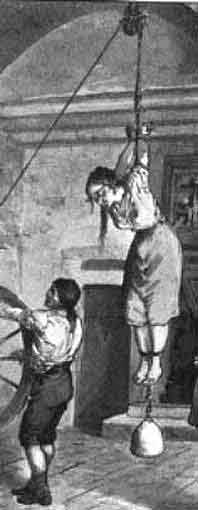Strappado
- For the Thoroughbred racehorse, see Estrapade (horse).

The Strappado is a form of torture in which the victim's hands are first tied behind his or her back and suspended in the air by means of a rope attached to wrists, which most likely dislocates both arms. Weights may be added to the body to intensify the effect and increase the pain.
Other names for strappado include "reverse hanging" and "Palestinian hanging" (although it is not used by the Palestinian Authority).[1][2] It is best known for its use in the torture chambers of the medieval Inquisition.[3]
Variants
There are three variants of this torture. In the first, the victim has his or her arms tied behind their back; a large rope is then tied to the wrists and passed over a pulley, beam, or a hook on the roof. The torturer pulls on this rope until the victim is hanging from the arms. Since the hands are tied behind the victim's back, this will cause a very intense pain and possible dislocation of the arms. The full weight of the subject's body is then supported by the extended and internally rotated shoulder sockets. While the technique shows no external injuries, it can cause long-term nerve, ligament, or tendon damage. The technique typically causes brachial plexus injury, leading to paralysis or loss of sensation in the arms.
The second variation is similar to the first, but a series of drops is added, meaning that the victim is allowed to drop until his or her fall is suddenly checked by the rope. In addition to the damage caused by the suspension, the painful jerk would cause major stress to the extended and vulnerable arms, leading to broken shoulders. It is believed that Niccolò Machiavelli, during his 1513 imprisonment after allegedly conspiring against the Medici family in Florence, was subjected to this form of strappado.
In the third variant, the victim's hands are tied to the front. The victim is also hung from the hands, but the ankles are tied and a heavy weight is attached to them. This will cause pain and possible damage not only to the arms, but also to the legs and hips. This variant was known as "squassation".
History
According to William Godwin, Girolamo Savonarola was tortured by strappado multiple times before being put to death in a trial by fire; Savonarola, however, apparently renounced his confessions after being tortured, which eventually led to his sentence of burning at the stake. This device was thought to be used during the Salem Witch Trials of Salem, Massachusetts in 1692 to torture accused witches.
Modern instances

In the Sachsenhausen concentration camp, prisoners were punished by having their hands tied behind their back, and then being suspended on a pole with their feet just above the ground for half an hour. This was also systematically used in Dachau Concentration Camp for infringement of camp rules. Originally the punishment used tree branches, but it was moved into a shower room on special poles so that victims could not relieve the pain as they could by using the tree.
The "ropes" were one of several torture methods employed at the Hỏa Lò Prison, popularly known as the Hanoi Hilton.[4] The site was used by the North Vietnamese Army to house, torture and interrogate captured servicemen, mostly American pilots shot down during bombing raids (including USAF officer Joseph Kittinger).[5] The aim of the torture was usually not acquiring military information; rather, it was to break the will of the prisoners, both individually and as a group, and to get written or recorded statements from the prisoners that criticized U.S. conduct of the war and praised how the North Vietnamese treated them.[6]
According to a 1997 Human Rights Watch report, this technique was "widely employed" by the security forces of Turkey, where it is "usually used together with high-pressure water, electric shock, beating, or sexual harassment such as squeezing the testicles or breast or placing a nightstick against or in the vagina or anus".[7] In 1996, the European Court of Human Rights found Turkey guilty of torture for its use of reverse hanging.[8] Turkey has been admonished by Amnesty International and other international human rights groups concerning the use of the technique.
In 2003, one of the Bulgarian nurses interrogated during the HIV trial in Libya, Snezhana Dimitrova, stated that she had been tortured in this way.
"They tied my hands behind my back. Then they hung me from a door. It feels like they are stretching you from all sides. My torso was twisted and my shoulders were dislocated from their joints from time to time. The pain cannot be described. The translator was shouting, 'Confess or you will die here.'"
References
- ↑ Goldhaber, Michael (2007). A People's History of the European Court of Human Rights. Rutgers University Press. p. 109. ISBN 978-0-8135-3983-6.
- ↑ Rejali, Darius (2007). Torture and Democracy. Princeton University Press. p. 355. ISBN 978-0-691-11422-4.
- ↑ Inquisition from Its Establishment to the Great Schism: An Introductory Study Authors A. L. Maycock, Ronald Knox Publisher Kessinger Publishing, 2003 ISBN 0-7661-7290-2,ISBN 978-0-7661-7290-6 Length 316 pages p.162
- ↑ "The Prisoner", New York Times.
- ↑ Karnow, Stanley (1983). Vietnam: A History. The Viking Press. ISBN 0-670-74604-5. p. 655.
- ↑ Hubbell, P.O.W., pp. 288–306.
- ↑ TURKEY: TORTURE AND MISTREATMENT IN PRE-TRIAL DETENTION BY ANTI-TERROR POLICE - Techniques of Abuse
- ↑ Aksoy v. Turkey, no. 100/1995/606/694, December 18, 1996, from the Human & Constitutional Rights Resource Page
European Commission on Human Rights, Aksoy v. Turkey, Publication 1996-VI, no. 26, December 18, 1996, from the Netherlands Institute of Human Rights